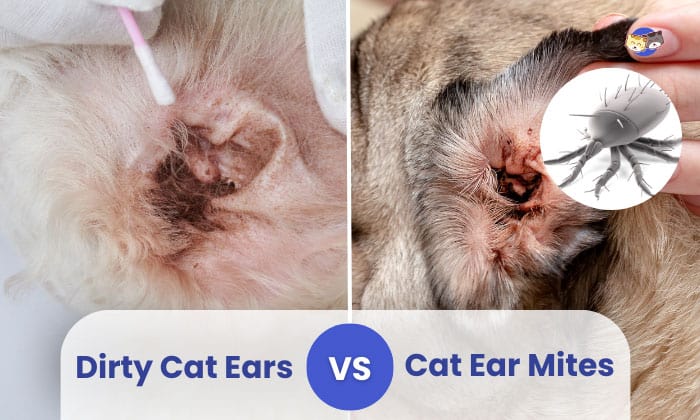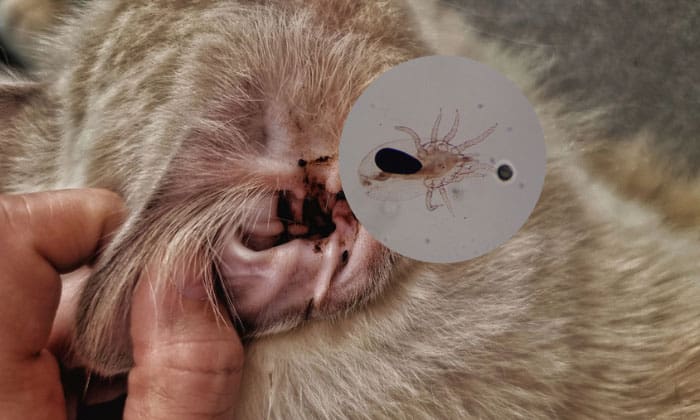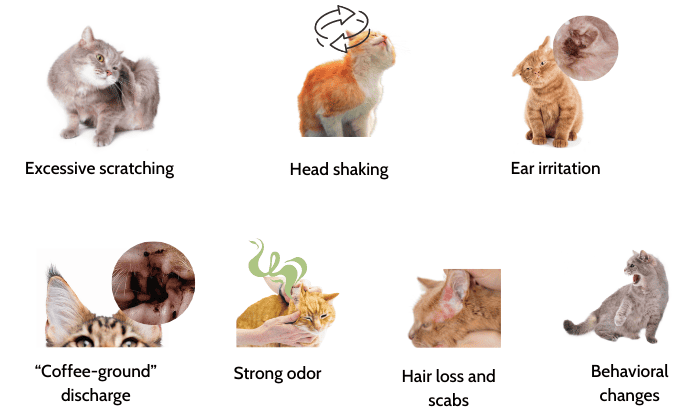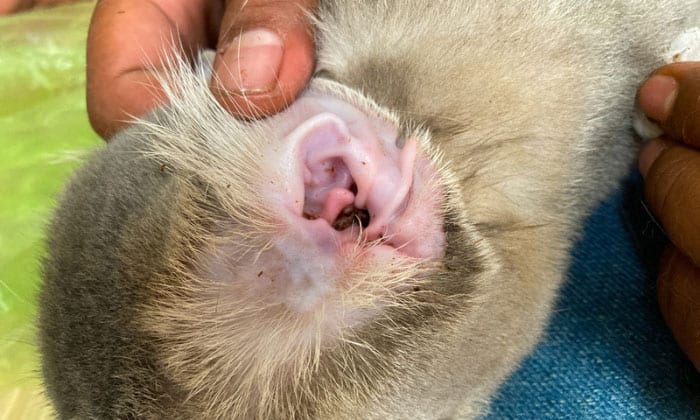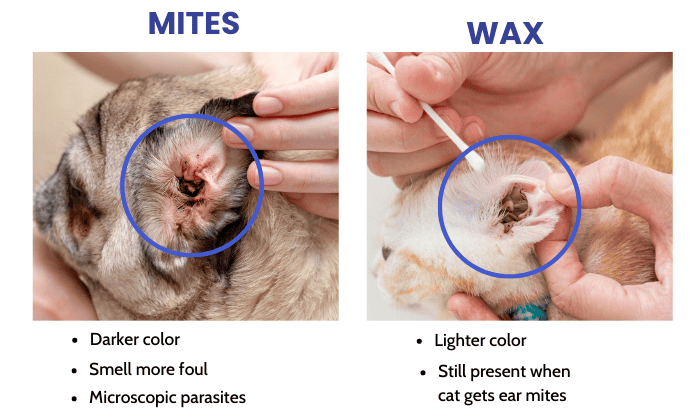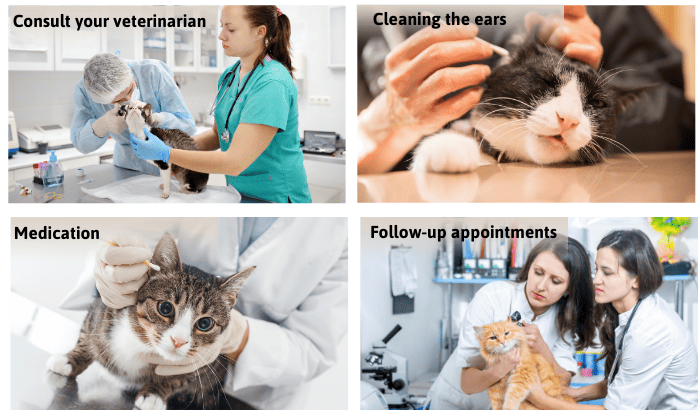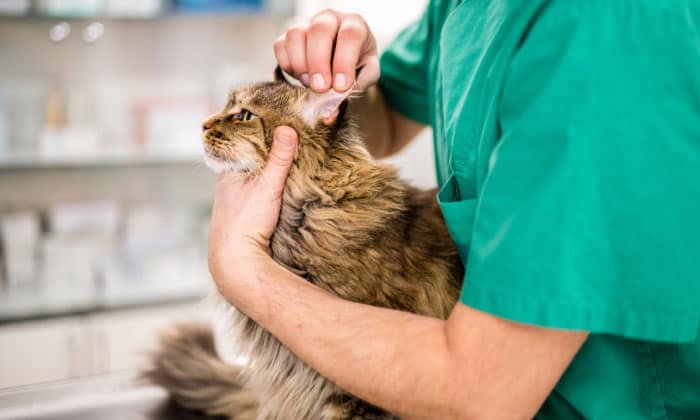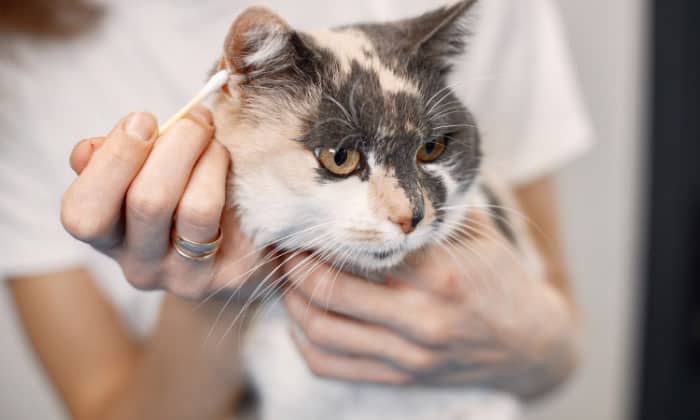A cat’s ears, with their delicate structure, play an integral role in cats’ daily lives. But what happens when those seemingly innocent parts appear dirty or neglected?
Your feline companions are meticulous groomers by nature. The fact that their ears become unusually dirty or produce strange discharge could be a sign of underlying problems. One of them is the presence of ear mites.
In this article, we’ll uncover the difference between dirty cat ears vs ear mites. From identifying ear mites to understanding their causes and finding the proper treatments, we aim to empower you with everything needed to care for your pets’ ears and their overall well-being.
| Dirty Ears | Ear Mites | |
| Cause | Accumulation of wax, dirt, and debris | Tiny parasites feeding on ear debris |
| Symptoms | Mild irritation, itching, or odor | Severe irritation, inflammation, infection, or odor |
| Prevention | Regular grooming, ear cleaning | Avoid contact with infected animals, treat all pets |
| Treatment | Clean with natural remedies | Vet medication or natural remedies |
| Contagious | Not contagious | Highly contagious to animals, rarely to humans |
Table of Contents
What is Cat Ear Mites?
Ear mites, also known as Otodectes cynotis, are tiny parasites that infest animals’ ears. They live and multiply within the ear canal, feeding on the wax, oils, and skin cells found there. This feeding activity leads to inflammation, itching, and the accumulation of dark, crumbly discharge in the ears.
Ear mites are a common problem in cats. While not life-threatening, they can cause discomfort and irritation.
How do cats get ear mites? They easily spread from one cat to another (or even from dogs to cats) through close contact in grassy areas or animal shelters with poor hygiene.
Signs of Ear Mites in Feline
The mites themselves are barely visible to the naked eye and are usually light-colored. Thus, the only way to check for ear mites in cats is via using the microscope.
However, there are some symptoms that might help you determine whether your cats have ear mites. Pay attention to these signs first and take your pets to the vet later for further examination.
- Excessive scratching: Cats with ear mites often use their paws to aggressively scratch their ears or rub their heads against objects to relieve the itchiness.
- Head shaking: They may vigorously shake or tilt their heads in an attempt to alleviate the discomfort.
- Ear irritation: You may notice your cat’s ears becoming red and sensitive.
- “Coffee-ground” discharge: Ear mites can cause the production of a dark discharge (a combination of black ear wax, blood, and secretions) which visually differs from what normal cat ear wax look like.
- Strong odor: The discharge can lead to a foul odor emanating from your cat’s ears.
- Hair loss and scabs: In severe cases or when the infestation is left untreated, cats may develop hair loss around the ears and form scabs due to scratching.
- Behavioral changes: Some cats may become irritable and agitated as a result of the discomfort caused by the mites.
Learn more in the details about “Signs to Know Your Cat Has Ear Mites” here!
What is Dirty Cat Ears?
Cat ear wax is a substance produced by glands in a cat’s ear canal. Since this is a normal physiological process in cats, fear not if you spot a little amount of wax in your cat’s ears.
What color is cat ear wax? Normal cat ear wax is typically brown if you look at pictures and has a waxy consistency.
Cats are generally good at grooming themselves. But those with old age, illness, obesity, mobility issues, or anatomical abnormalities might not do it effectively, resulting in a build-up of dirt and debris in their ears.
While a certain amount of brown wax in cat ears is normal and healthy, excessive accumulation can lead to dirty cat ears or indicate other severe issues such as ear infections or ear mites.
Difference of Cat Ear Mites Vs Wax
Actually, ear mites vs ear wax in cats are two distinct conditions. While the latter with excessive wax build-up is visible to human eyes, the former with microscopic parasites are barely seen.
Ear wax is still present when your cat gets ear mites, but if you look at a color chart, normal wax tends to be lighter than ear mite wax (light vs. dark brown), and the latter type of buildup will also smell more foul.
Cat ear wax color aside, healthy felines will have light pink inner ears.
How to Treat Ear Mites in Cats
Cat ear mite treatment typically involves a combination of cleaning, medication, and preventive measures. See below for a step-by-step guide to get rid of those parasites soon and bring your cat’s ears back to normal.
- Consult your veterinarian: Before beginning any treatment, it’s important to have your cat examined by a vet to confirm the presence of ear mites. Then, they will provide guidance specific to your cat’s condition and recommend appropriate treatments.
- Cleaning the ears: This step is crucial to make sure the next treatment of medication runs smoothly and effectively.
You need to use a recommended ear-cleaning tool (such as a clean cotton ball or gauze) to wipe away any dirt, debris, or excess dark wax. Some vets may recommend a cleaning solution as well.
- Medication: Your vet may prescribe ear drops, ointments, spray, or oral medications to eliminate ear mites. Follow the instructions carefully. It’ll take at least three weeks to dispose of all mites and eggs.
- Follow-up appointments: It’s crucial that the vet examine your cat’s ears regularly to ensure the treatment is effective and provide further guidance if needed.
Tips to Keep My Cat’s Ears Healthy
Good ear health contributes to your cats’ overall well-being. Follow the tips below to keep their ears clean, help them function properly, and reduce any risk of infections or ear mites.
- Regularly check your cat’s ears for any signs of redness, swelling, or unpleasant odor. If you notice any abnormalities, consult your veterinarian immediately.
- When you find an excessive amount of black stuff in cat ear, not mites, your feline may have another type of infection like otitis externa or a fungal, bacterial disease. Have your vet perform a checkup for a correct diagnosis.
- Keep an eye out for signs of ear issues, such as excessive scratching, head shaking, sensitivity when touched, or changes in behavior.
- It’s essential to include your pet’s ears in the veterinary check-ups. A vet will perform a thorough examination, clean the ears if necessary, address any concerns, and give timely treatment if there’s any problem.
Frequently Asked Questions
How to clean cat ears safely?
When it comes to cleaning your cat’s ears, the following guide would be helpful.
- Prepare the supplies needed: cotton balls or pads, cleaning solution, and treats (optional).
- Approach your cat calmly and slowly to avoid startling them. Then, take a moment to inspect their ears for any abnormal signs.
- Gently lift your cat’s earflap and place a few drops of the solution into the ear canal.
- Gently massage the base of your cat’s ear for about 5-10 seconds to distribute the cleaning solution and loosen any wax or debris.
- Release the ear and allow your cat to shake their head to dislodge the loosened wax from the ear canal.
- Take a cotton ball or pad and gently wipe the visible parts of the ear canal, removing any wax or debris that comes out. Avoid pushing the cotton ball too deep into the ear canal to prevent injury.
- Repeat the same process on the other ear.
- After you’ve finished cleaning both ears, reward your cat with treats or praise to make the experience more enjoyable for them.
How often should you clean your cat ears?
Generally, a healthy cat with normal ears may not require regular ear cleaning. If you see their ears getting dirty for a while, you can ask for vet advice and start the cleaning process.
Do not over-clean your cat ears. Once in three months is fine.
Conclusion
It is crucial to distinguish between dirty cat ears vs ear mites, as they require different approaches for diagnosis and treatment.
While dirty ears in cats can usually be addressed through regular cleaning practices and proper hygiene, ear mites require appropriate treatments, and they can cause significant discomfort and health issues if left unaddressed.
Bear in mind that prevention is better than cure. Maintaining good ear hygiene for your pets is crucial to prevent unexpected problems. However, when symptoms persist, it is vital to consider the possibility of ear mites and consult your vet for further advice.
Another comparison: Yeast Infection vs Cat Ear Mitet – Distinguishing the Differences.

I am Amy Sawy, a Doctor of Veterinary Medicine (DVM) graduate from the University of Kansas. y husband, Dr. Plummer, and I own a veterinary clinic in Phillipsburg, Kansas. In addition to my professional background, I am a devoted pet owner myself, with a household that includes dogs, rodents, and most notably, cats – a total of five felines in my home.
In 2020, I joined an organization as a professional writer, leveraging my experience and collaborating with my team to deliver the most valuable information for your cat’s care.


